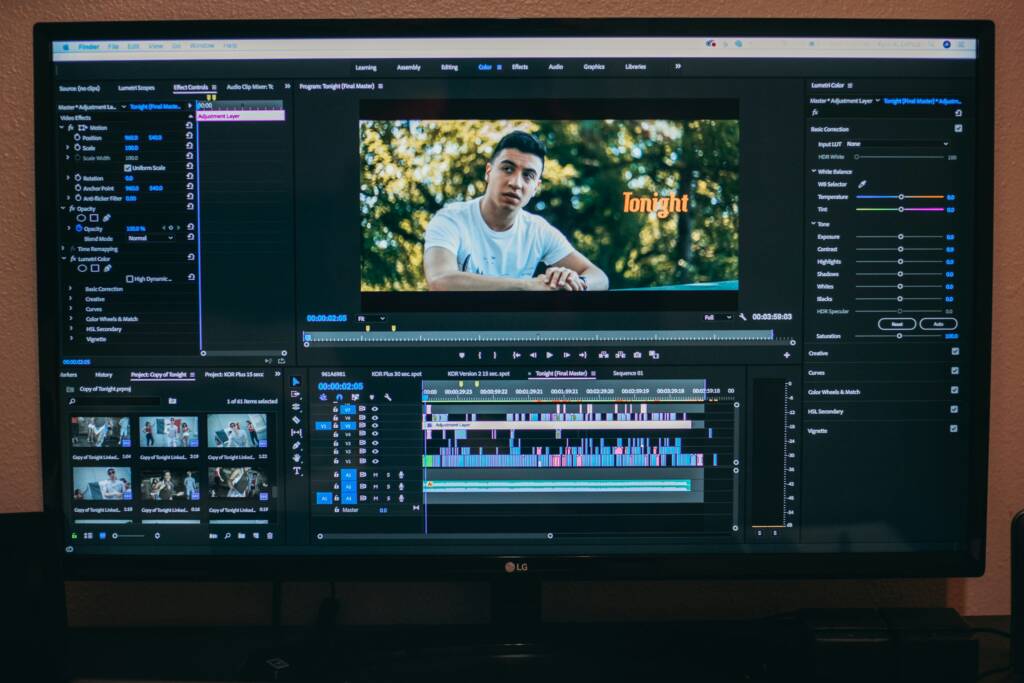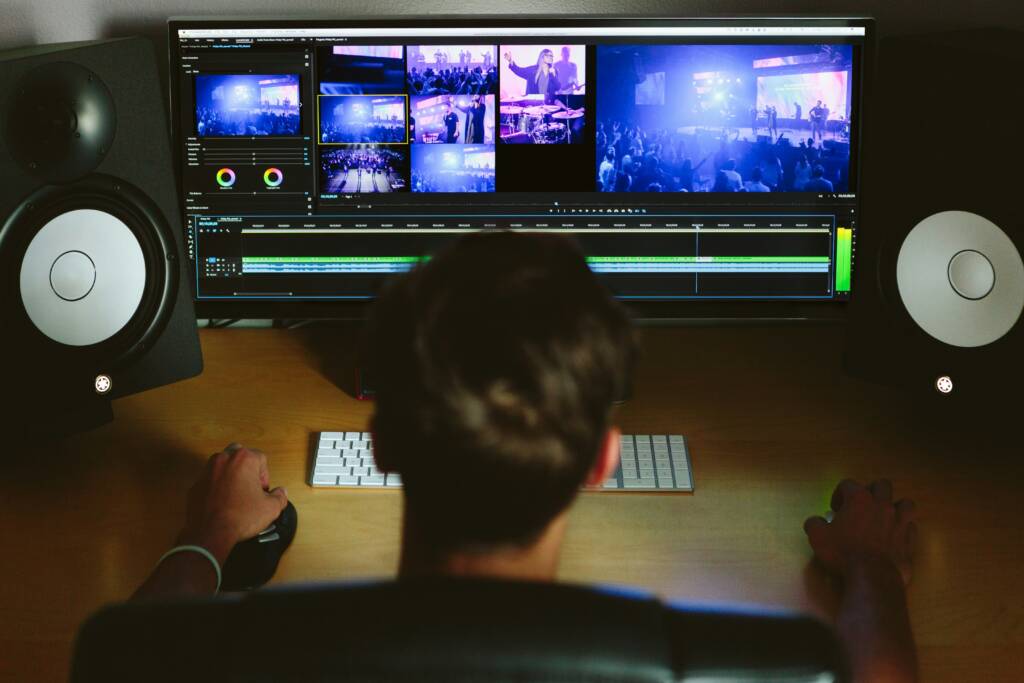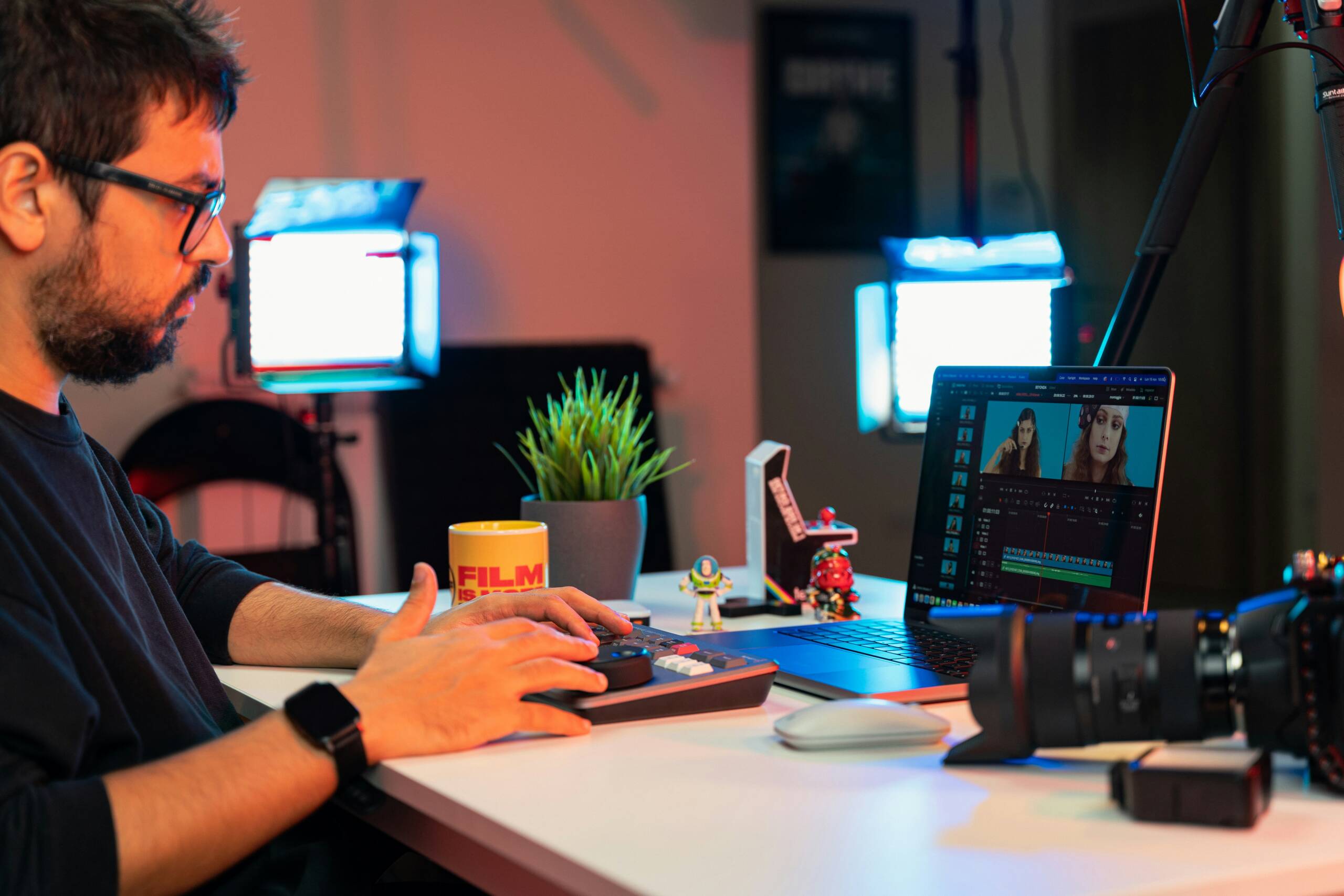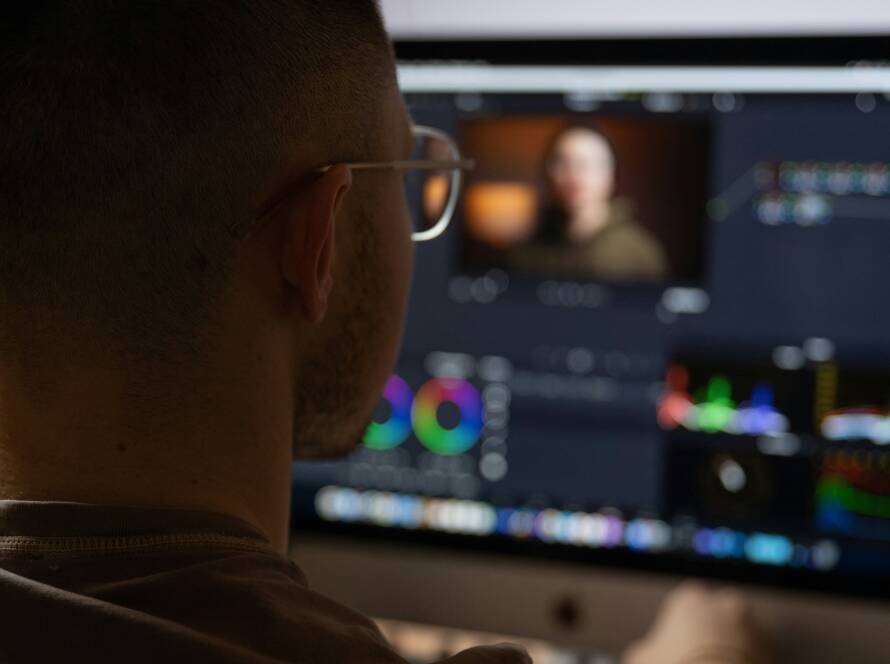Most of the viewers can tell if a video has a high-quality video edit or when a video is not well edited. This element is important in keeping viewer retention and engagement.
In this article one of our video experts will share tips and knowledge about how to achieve high-quality video edits.
Table of Content
- Basics of Video Editing
- Elements of Video Editing
- What to Avoid in Video Editing
- 1. Choosing the Right Video Clips
- 2. Considering Color Grading for the Atmosphere of the Video
- 3. Adding the Right Amount of Visual Effect
- 4. Having the Right Music and Sound
- 5. Assessing Final Cut
- FAQ
- What are the basic elements of video editing that I need to consider when hiring a professional?
- How crucial is the process of choosing the right video clips in video editing?
- What exactly is color grading and why is it important in video editing?
- Can a video have too much visual effect?
- How critical is the role of music and sound in video editing?
- What should I look for in the final cut of the video?
- Hiring a Professional Video Editor
Basics of Video Editing
Video editing is more than simply sticking clips together; it’s an art. It’s that sprinkle of magic that breathes life into raw footage, painting a compelling picture that captures the viewer’s attention, keeping them glued to the screen till the very end. This masterstroke of creativity, though, isn’t an impromptu performance; rather, it stems from a meticulous understanding of several core principles such as timing, pacing, and continuity, among other things.
Let’s kick the tires and light the fires! High-quality video editing should be like a well-cooked dish, a delicate balance of flavors that tantalizes the taste buds of the viewer. Each clip, each transition, every visual effect, and each soundbite must blend seamlessly, the resulting symphony captivating the viewer in an immersive experience. Editing is the secret sauce that turns even the most ordinary footage into a smorgasbord of stunning visuals and sounds. So put on your chef’s hat, roll up the proverbial sleeves, and it’s time to whip up some video-editing magic. Your audience’s eyeballs will thank you for it.
Elements of Video Editing
Immersing oneself in the intricate world of video editing can be an amazing adventure! It’s like piecing together a jigsaw puzzle, but instead of a static picture, you’re creating a dynamic story that unfolds over time. The tools and techniques might seem overwhelming at first, but every successful video edit starts with an understanding of a few core elements. It’s essential to first grasp three pivotal components – the vision, the footage, and the editing software.
The vision is your roadmap, guiding the story direction and style you’re aiming to achieve. The footage, of course, is the raw material you’ll be manipulating to bring that vision to life. It might include video clips, still images, graphics, and other visual elements. The editing software is your toolbox, providing the means to shape your footage into your final video. Whether you’re going for that epic cinematic vibe, an intimate personal memoir, or a fast-paced comedy sketch, understanding these foundational elements of video editing allows you to drive your story in any direction you choose.
What to Avoid in Video Editing
Well, let’s get straight to the point. In the wonderful journey of learning how to edit video, there are a couple of speed bumps you might want to swerve around. The first of those has got to be overdoing the special effects. Sure, those dazzling transitions and glowing text features look tempting, but let me tell you, less is more. You might think filling your video with all the bells and whistles will make it stellar, but what you’re really doing is taking away from the core content. Nobody likes to watch a video that looks more like a unicorn threw up on it.
The second thing: never, and I mean NEVER, ignore the video’s pacing. A video’s pacing is kinda like the rhythm in music – it’s crucial to the overall harmony. You wouldn’t want to listen to a song that unexpectedly stops mid-chorus or one that suddenly rushes through its bridge, right? The same principle applies to video editing. Remember, when you’re learning how to edit video, understanding pacing is as important as choosing the right effects. Keep it smooth, steady, engaging, and for the love of cinema, do not cram in too many different ideas all at once. Like a well-made sandwich, a good video needs balance and structure, not an overflow of mismatched ingredients. Trust me, your audience will thank you!
1. Choosing the Right Video Clips
The journey of a video from humdrum to fantastic often starts with choosing the right video clips. You’d think this is a no-brainer, right? Well, ask any seasoned video editor and they’ll tell you – not quite. Being selective with your clips is not just about picking flashy visuals or those that simply look pretty. Oh no, it’s about choosing those magic moments that contribute to telling your story as authentically and effectively as possible. It’s a precise process, as meticulous as a surgeon’s touch, requiring nothing less than an eagle eye for detail.
Now, this isn’t to say you have to go all Sherlock Holmes on your clips, but a bit of the detective’s discernment wouldn’t hurt. A good video editor knows that each clip holds a piece of the puzzle that is your narrative. It’s like sifting through sand for nuggets of gold. You have to scan through countless clips, zero in on those powerful snippets, and say a polite ‘no thank you’ to the rest. Yes, it can be painstaking, but oh boy, does the end result make every second worth it! And remember folks –– when it comes to creating arresting content, quality always trumps quantity. After all, who watches a video for its length? We’re here for the punch, for the dynamism, for the narrative that keeps us hooked. Now go forth and choose your clips wisely… your audience awaits!
2. Considering Color Grading for the Atmosphere of the Video
Color grading in video editing is much like the secret sauce in your favorite burger – it’s not immediately noticeable, but it significantly enhances the overall experience. Think about your favorite YouTube video, and you’ll probably realize that the colors in the video were just right. They set the tone, mood, and overall atmosphere of the piece, catching your eye and making the content more enjoyable to watch.
It’s much like a chameleon, a video can adapt to the mood and environment you want your audience to perceive, just by changing the color grading. If you’re going for a 1970s retro look, you might use warm, saturated colors. Or if you’re making a suspenseful short film, you’ll probably use a lot of blue and desaturated colors. While color grading might not be the first thing that comes to mind when creating a YouTube video, it’s crucial to consider. It can help transform your raw footage into an expressive, lively, and immersive viewing experience. So, dip your toes in the world of color grading, and you’ll soon find yourself swimming in a sea of creative possibilities.
3. Adding the Right Amount of Visual Effect
While visual effects can bring a video to life and add interest, they also can become a distraction if not used ingeniously. Adobe, with its diverse array of editing software, has become the go-to tool for creators eyeing to experiment with visual effects. Knowing when, where, and how to use these effects is crucial in striking a balance. Go too heavy on effects and your video becomes a wild neon ride through a psychedelic circus, too light and it might lack the zest!
This is where the benefits of simply ‘trying, failing, and learning’ kick in. Using Adobe’s effects, experimenting with them, and gaining an understanding of what each one does takes time, but it’s a rewarding process. In this digital age where most content creators are self-taught, online tutorials and guides are precious gold mines. And guess what, there’s nothing more satisfying than that magical moment when you find the perfect visual effect, that makes your video story captivating, not just another show of flashy glitz. Despite all the flashy tech and the thousand options out there, remember the golden mantra: moderation is the key!
Imagine it like seasoning a dish. You wouldn’t want to add so much spice that it overshadows the taste of the food, nor would you prefer it bland without any seasoning at all. The same goes for your video editing as well; adding just the right amount of visual effects makes your content pop without being too overwhelming.
4. Having the Right Music and Sound
Music and sound play a pivotal role in setting the mood and tone of a video. Imagine watching a comic clip with a dramatic rhythm chiming in, quite unsettling, isn’t it? At Social Channel Studios, we understand how these elements can either make or break the viewer experience. Whether it’s a catchy tune playing in the background of a travel vlog, the adrenaline-pumping beats during a fitness routine, or just the soothing sound of waves in a calming mindfulness video, the right choice of music and sound can significantly elevate your content, making it more engaging and appealing to the audience.
Choosing the right audio isn’t just limited to matching the vibe of the video, but it also involves the technical aspect of syncing the audio with the visuals. A mismatch can lead to an awkward viewing experience. For instance, if the protagonist’s lips are moving but the audio comes in half a second later, the magic is lost, isn’t it? That’s why it’s important to tweak and fine-tune the elements to ensure that they resonate perfectly with the intended rhythm of your video. Sometimes, even the absence of sound, a well-placed pause, can create an impact. It’s all about striking that perfect balance, a dance between sight and sound.
At Social Channel Studios, we focus on several key aspects to ensure the audio and video synchronization is seamless:
• Selecting the right music: We understand that every video has a unique vibe and requires an equally distinctive soundtrack. Our team takes time to carefully select or compose music that perfectly complements the content of your video.
• Syncing visuals with audio: It’s not just about having great visuals and excellent sound; they need to work together harmoniously. We pay close attention to detail when syncing both elements, ensuring there are no awkward gaps or delays.
• Balancing soundscape: While it’s essential to have background music or ambient noise in a video, it shouldn’t overpower the main dialogue or narration. We make sure all sounds are mixed at appropriate levels for optimal viewing experience.
• Using silence effectively: Sometimes, less is more! Strategic use of silence can highlight important moments in your videos and create dramatic effects.
5. Assessing Final Cut
In the world of content creation, inspecting the final cut of your video is like serving up a carefully crafted dish and then wondering, “Does it need more salt?” You’ve whisked together the elements of video editing, thrown in top-tier video clips, given careful consideration to color grading, stirred in the right dose of visual effects, and added a dash of solid sound and music. But before you serve it to your audience, it’s crucial to have one final taste test to ensure it’s absolutely delectable.
Before you hit that ‘Upload’ button, don the hat of your most voracious viewer. Watch the final cut with fresh eyes while munching on a bowl of popcorn. If your own content doesn’t draw you in, tickle your humor, or touch your heart, don’t expect your viewers to feel differently. Take notes and don’t shy away from last-minute adjustments. Remember, perfection lies in minute details. And finally, don’t forget to run a basic checklist. Is the thumbnail intriguing enough? Does the video’s atmosphere vibe with the audience? Is the content silver-tongued and easy to understand? Your final cut should check all these boxes. With just a pinch of expert help and a dash of creativity, your final video cut could be so scrumptious, that your viewers would not just consume, it but feast on it!
Don’t forget to check out this video about how to successfully catch viewers’ attention and engagement with professional video editing.
FAQ
What are the basic elements of video editing that I need to consider when hiring a professional?
When hiring a professional video editor, you should consider their understanding and ability to execute the basics of video editing. This includes selecting the right video clips, color grading, adding the right amount of visual effects and sound, and ensuring a polished final cut.
How crucial is the process of choosing the right video clips in video editing?
Choosing the right video clips is a fundamental part of video editing. The clips you choose set the tone and narrative of the video. A professional video editor will have the skills to select and sequence clips effectively to portray your message or story.
What exactly is color grading and why is it important in video editing?
Color grading is the process of altering and enhancing the color of a video. It sets the mood and atmosphere, helps to tell your story, and brings consistency to your footage. A professional video editor will know how to color grade effectively to get the desired effect.
Can a video have too much visual effect?
Yes, a video can have too much visual effect. Overloading a video with visual effects can distract from the message or story you are trying to portray. A professional video editor will know how to strike the right balance.
How critical is the role of music and sound in video editing?
Music and sound play a vital role in video editing. They help to set the tone, pace, and mood of the video. An effective video editor will know how to choose and integrate sound effectively to enhance your video.
What should I look for in the final cut of the video?
In the final cut, look for a seamless flow of the video, effective use of visual effects, appropriate color grading, and the overall quality of the sound. It should effectively communicate your message or story.
Hiring a Professional Video Editor


If you’re a content creator producing content across various platforms like YouTube, Facebook, Instagram, and Twitter, you know the trials and tribulations of the video editing process. It’s a meticulous endeavor that requires creativity, technical competence, and a keen attention to detail. Here’s where the idea of hiring a professional video editor or a studio like Social Channel Studios becomes a crucial factor. These studios possess an arsenal of knowledge in creating click-worthy thumbnails, engaging visuals, and crisp and intelligible text—the elements that turn viewers into fans.
Now, you might wonder, “Why hire someone to do what I myself could probably manage?” And you’re right, you could. However, consider this—quality, expertise, and efficiency. Professional studios excel in these areas, they’ll help craft content that doesn’t just meet standards but stands out. An editor’s skillset includes but isn’t limited to color grading mastery, ingenious use of visual effects, the strategic addition of sound and music, and the ability to make the right final cut decisions. Let’s not forget, that beyond the perk of quality content, hiring a professional studio also allows creators to focus on what they do best—being creative and original. So, in essence, you’re not just buying the editor’s skills, you’re buying yourself the freedom to enjoy life and create even more.
If you are interested in hiring us or learning more about our services, please contact us today or book a free consult with one of our specialists. We look forward to working with you!


